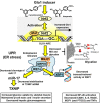Emerging Glycation-Based Therapeutics-Glyoxalase 1 Inducers and Glyoxalase 1 Inhibitors
- PMID: 35269594
- PMCID: PMC8910005
- DOI: 10.3390/ijms23052453
Emerging Glycation-Based Therapeutics-Glyoxalase 1 Inducers and Glyoxalase 1 Inhibitors
Abstract
The abnormal accumulation of methylglyoxal (MG) leading to increased glycation of protein and DNA has emerged as an important metabolic stress, dicarbonyl stress, linked to aging, and disease. Increased MG glycation produces inactivation and misfolding of proteins, cell dysfunction, activation of the unfolded protein response, and related low-grade inflammation. Glycation of DNA and the spliceosome contribute to an antiproliferative and apoptotic response of high, cytotoxic levels of MG. Glyoxalase 1 (Glo1) of the glyoxalase system has a major role in the metabolism of MG. Small molecule inducers of Glo1, Glo1 inducers, have been developed to alleviate dicarbonyl stress as a prospective treatment for the prevention and early-stage reversal of type 2 diabetes and prevention of vascular complications of diabetes. The first clinical trial with the Glo1 inducer, trans-resveratrol and hesperetin combination (tRES-HESP)-a randomized, double-blind, placebo-controlled crossover phase 2A study for correction of insulin resistance in overweight and obese subjects, was completed successfully. tRES-HESP corrected insulin resistance, improved dysglycemia, and low-grade inflammation. Cell permeable Glo1 inhibitor prodrugs have been developed to induce severe dicarbonyl stress as a prospective treatment for cancer-particularly for high Glo1 expressing-related multidrug-resistant tumors. The prototype Glo1 inhibitor is prodrug S-p-bromobenzylglutathione cyclopentyl diester (BBGD). It has antitumor activity in vitro and in tumor-bearing mice in vivo. In the National Cancer Institute human tumor cell line screen, BBGD was most active against the glioblastoma SNB-19 cell line. Recently, potent antitumor activity was found in glioblastoma multiforme tumor-bearing mice. High Glo1 expression is a negative survival factor in chemotherapy of breast cancer where adjunct therapy with a Glo1 inhibitor may improve treatment outcomes. BBGD has not yet been evaluated clinically. Glycation by MG now appears to be a pathogenic process that may be pharmacologically manipulated for therapeutic outcomes of potentially important clinical impact.
Keywords: SARS-CoV-2; cancer chemotherapy; diabetes; dicarbonyl stress; glyoxalase; malaria; methylglyoxal; resveratrol.
Conflict of interest statement
The authors declare no conflict of interest.
Figures



Similar articles
-
Glyoxalase 1 Modulation in Obesity and Diabetes.Antioxid Redox Signal. 2019 Jan 20;30(3):354-374. doi: 10.1089/ars.2017.7424. Epub 2018 Jan 2. Antioxid Redox Signal. 2019. PMID: 29160087 Review.
-
Reversal of Insulin Resistance in Overweight and Obese Subjects by trans-Resveratrol and Hesperetin Combination-Link to Dysglycemia, Blood Pressure, Dyslipidemia, and Low-Grade Inflammation.Nutrients. 2021 Jul 11;13(7):2374. doi: 10.3390/nu13072374. Nutrients. 2021. PMID: 34371884 Free PMC article. Clinical Trial.
-
Improved Glycemic Control and Vascular Function in Overweight and Obese Subjects by Glyoxalase 1 Inducer Formulation.Diabetes. 2016 Aug;65(8):2282-94. doi: 10.2337/db16-0153. Epub 2016 May 11. Diabetes. 2016. PMID: 27207552 Clinical Trial.
-
Methylglyoxal-induced dicarbonyl stress in aging and disease: first steps towards glyoxalase 1-based treatments.Clin Sci (Lond). 2016 Oct 1;130(19):1677-96. doi: 10.1042/CS20160025. Clin Sci (Lond). 2016. PMID: 27555612 Review.
-
Multiple roles of glyoxalase 1-mediated suppression of methylglyoxal glycation in cancer biology-Involvement in tumour suppression, tumour growth, multidrug resistance and target for chemotherapy.Semin Cancer Biol. 2018 Apr;49:83-93. doi: 10.1016/j.semcancer.2017.05.006. Epub 2017 May 12. Semin Cancer Biol. 2018. PMID: 28506645 Review.
Cited by
-
The Glycolysis-derived α-Dicarbonyl Metabolite Methylglyoxal is a UVA-photosensitizer Causing the Photooxidative Elimination of HaCaT Keratinocytes with Induction of Oxidative and Proteotoxic Stress Response Gene Expression†.Photochem Photobiol. 2023 Mar;99(2):826-834. doi: 10.1111/php.13717. Epub 2022 Oct 6. Photochem Photobiol. 2023. PMID: 36109156 Free PMC article.
-
Dual Glyoxalase-1 and β-Klotho Gene-Activated Scaffold Reduces Methylglyoxal and Reprograms Diabetic Adipose-Derived Stem Cells: Prospects in Improved Wound Healing.Pharmaceutics. 2024 Feb 13;16(2):265. doi: 10.3390/pharmaceutics16020265. Pharmaceutics. 2024. PMID: 38399319 Free PMC article.
-
S-p-bromobenzyl-glutathione cyclopentyl diester (BBGC) as novel therapeutic strategy to enhance trabectedin anti-tumor effect in soft tissue sarcoma preclinical models.Oncogene. 2024 Sep;43(40):2986-2994. doi: 10.1038/s41388-024-03143-9. Epub 2024 Aug 28. Oncogene. 2024. PMID: 39198616 Free PMC article.
-
Molecular Assessment of Methylglyoxal-Induced Toxicity and Therapeutic Approaches in Various Diseases: Exploring the Interplay with the Glyoxalase System.Life (Basel). 2024 Feb 17;14(2):263. doi: 10.3390/life14020263. Life (Basel). 2024. PMID: 38398772 Free PMC article. Review.
-
Parkinsonism-Associated Protein DJ-1 Is an Antagonist, Not an Eraser, for Protein Glycation.Biochemistry. 2023 Mar 21;62(6):1181-1190. doi: 10.1021/acs.biochem.3c00028. Epub 2023 Feb 23. Biochemistry. 2023. PMID: 36820886 Free PMC article.
References
-
- Thornalley P.J., Waris S., Fleming T., Santarius T., Larkin S.J., Winklhofer-Roob B.M., Stratton M.R., Rabbani N. Imidazopurinones are markers of physiological genomic damage linked to DNA instability and glyoxalase 1-associated tumour multidrug resistance. Nucleic Acids Res. 2010;38:5432–5442. doi: 10.1093/nar/gkq306. - DOI - PMC - PubMed
Publication types
MeSH terms
Substances
Grants and funding
LinkOut - more resources
Full Text Sources
Other Literature Sources
Medical
Research Materials
Miscellaneous

